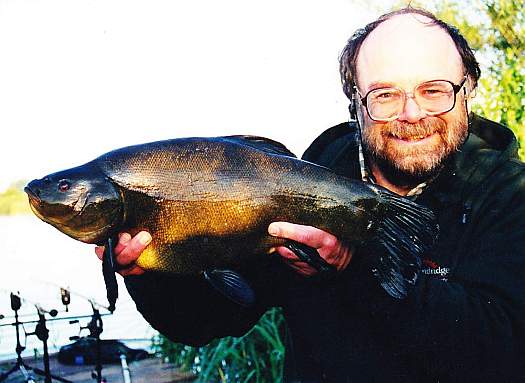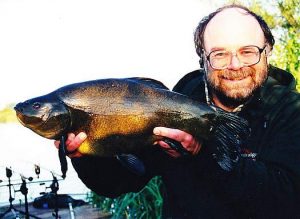The following is based on my experiences since creating my own gravel pit fisheries at Wingham in Kent that several members of the Tenchfishers belong to. I’m convinced the theory is correct at Wingham; it may well be the case on other waters, particularly those with lots of bars and other features. So, hopefully, what I’ve found will be useful to others.
Before I go any further it’s relevant to describe the history of the fishery for reasons you’ll see later. There are two gravel pits that fishing is allowed on. I’ll ignore the 15 acre Carp Lake here as it contains just carp, pike and eels. However, the 40 acre Main Lake contains most species, including tench.
When I got hold of the site in 1993, both lakes had been stocked with brown trout, with all but a few having died out or been poached. A quick survey had shown that the Carp Lake was more or less empty, but that the Main Lake was stuffed full of fish. Unfortunately, test fishing showed that there were only predators! There was the odd big brownie, plus lots of eels and zillions of pike, nearly all of the latter very small. I knew I had to stock the Carp Lake, but I hadn’t budgeted on stocking the Main Lake as well!
First of all, though, I had to thin out the pike in particular, and this took a couple of years before restocking commenced. However, tench with the right pedigree were very hard to find, and so the first ones didn’t go in until 1996. These came from two sources. The first were some dark green tench that came from a Surrey gravel pit. I stocked 96 in April 1996, averaging 3-06 up to exactly 5lbs. The second was a Kent estate lake that had a reputation for very big tench, but was very private and so almost unfished. These tench were black – the significance of which will become clear shortly.
In fact, I’d spent years trying to get permission to fish this estate lake, always without success until now. It wasn’t until one of my bailiffs revealed his cousin was the keeper on the estate, and also until I offered to buy the tench (at a very high price for the big ones!) that permission was finally granted. The deal negotiated allowed the two of us to fish with the keeper for one day twice a year. The first was to be a recce trip; the second would be when we could buy the fish.
On the first recce trip we had in 1996, we caught tench to 7lbs+, but it wasn’t until after they spawned that we were able to return with a big tank. In August 1996, I took all the few males we caught plus a selection of various size females so as to get different year classes. In total I bought 21 tench, nearly all 4lbs+ up to 6-04.
On the recce trip in 1997, we caught numbers of tench to over 8lbs, so they were obviously still growing. We, therefore, excitedly arranged the buying trip for earlier in the season so that the fish would spawn at Wingham and so increase our stock. Very frustratingly, on the appointed day we had a tremendous thunderstorm with local flooding. The level of the lake rose alarmingly, and we all blanked! So that was it for another season.
The following year was even more exciting, as it was clear the tench had grown even bigger. In fact, we caught fish to over 9lbs in May, but disappointingly the owner decided he wanted to keep these big ones after all, and moreover this was to be the last year of the arrangement. Nevertheless, I managed to buy 33 tench averaging 6-05 up to 8-06. Again, I took all the few males plus a selection of different size females.
So here was Wingham stocked with 2 different strains of tench that were easily told apart by their colour. What quickly became apparent was that they kept themselves to themselves, with areas producing either black or green tench. In only one swim did both consistently come out, and even then at different times of day. I suspect that this was where two patrol routes intersected.
What’s more, despite moving to a new environment, for some years the black tench continued to feed at the typical estate lake times of dawn and dusk. The dark green ones fed mainly later in the morning as is common with gravel pit tench.
However, something even more interesting was about to happen! Gradually, over a period of years, many of the black tench began to become blotchy in colour. You can see a good example from the picture below of a 9-04 I caught back in early June 2001.
What this meant was that it became possible to readily identify some individual tench. As a result, I discovered that most of the tench were always caught from their same home area. A minority, though, were confirmed wanderers. Best of all, these nomads tended to be quite a bit bigger! Could it be they had chosen this lifestyle because by doing so they got less competition and thus grew faster?
What also became apparent was that I often caught the nomads outside the normal feeding times. In particular, they often came after a normal feeding spell was over. More evidence of this surfaced in later years when syndicate members started putting together big bags of shoal tench. On many occasions, though, when they caught a biggie this would be one isolated fish after a biteless period. Could it be then that the nomads are also larger because they feed for longer each day?
Additionally, the nomads often seem to be caught in poor weather. A classic case was early June 2009, when just 3 tench were caught all week. I had a 10-06 one evening, plus a seven pounder the following morning. A couple of days later Glyn Llewellyn had a 10-04.
Now that entire period was chilly with fresh NE winds. That’s not especially unusual at Wingham, as we have our own microclimate, but that week the wind had just changed to a cold direction. In fact NE is the prevailing wind direction at Wingham all spring and, as such, a wind comes off the sea (which is chilly at that time of the year) and we’re often significantly colder and cloudier than just a few miles inland. As a result, our tench spawn late, typically well into July. On the other hand, we’re warmer in the autumn. Few ever fish at Wingham then, but last November my Head Bailiff did 2 successive Saturday overnighters before work parties and had one tench each trip, 8-04 one week and 9-05 the other.
Could it be then that the nomads are also bigger because they’re prepared to continue feeding in adverse conditions?
It’s interesting that in a Fish-In a few years ago, when we had a strong south-westerly, all the fish came in the teeth of the wind. However, at the other end of the lake, not a single tench was caught despite them rolling. I’d already come to the conclusion that the shoal tench at Wingham don’t move out of their home territory and follow the wind. Perhaps the nomads do, though? If so, by moving to areas where the conditions are better they’d have more opportunity to feed and grow bigger.
All this, of course, is speculation and only some of it may be right. However, over the years the evidence is steadily mounting that there are two types of tench, at least at Wingham. One lives in a shoal and has a home territory; the other is nomadic. It could be that these nomads go round in very small groups of say two or three. However, I suspect that many of them are loners. Most importantly, though, they’re on average quite a bit heavier. Some of the tench caught in a bag are big as well, and these may or may not be shoal fish. But it seems that the biggest ones are more likely to be solitary.
Some have suggested that these loners are simply the only one left of a shoal that has died out due to old age. On other waters I’d have accepted this as a possibility. However, at Wingham, all but a few of the tench are young.
These young fish are a third colour, namely yellow-green. It’s significant that there seems to be loners amongst these ones too, the same as the dark green and the black ones, and once again they’re usually bigger than the shoal tench.
These yellow-green ones are clearly young fish born at Wingham and, in fact, we’ve watched them grow at an even faster rate than their parents. Significantly, many of them have a long spine length but run out of girth near the tail. Fish breeder and fishery management consultant Ken Crow tells me that this is a sign of fast growers that have yet to fill out, which apparently they do from the head end first. It seems they typically grow in length for up to about fifteen years and then continue to fatten up over the next five years or so.

Some of the older Wingham tench are already very long. Indeed, the 10-02 dark green tench that Colin Allchin is holding in the picture above is 25 1/2ins long and, as you see, wasn’t full of spawn. As Tenchfishers’ Chairman Phil Jackson has pointed out, this is about as long as tench seem to grow. Interestingly, this fish was the first of Colin’s session and came at 5pm, normally just about the quietest time of the day at Wingham, and was followed by a fishless six hours. So, again, it fits in with the loner theory.
The final picture below shows me with one of the young yellow-green tench and you can clearly see the difference in colour. Again, it came after a long period of inactivity, this time after dark, with nothing more until the following day. It was also the only fish from that part of the swim. Despite being two months or more away from spawning and only just beginning to fill, it already weighed 10-04. This was in 2011, so I’d love someone to catch it this July at its heaviest weight of the season and with two extra years of growth, let alone in 2016 with five! Unfortunately, no one so far has caught one of these early season doubles near spawning time. With so few fishing (an average of just 4 on 40 acres even at that time of year), that’s not surprising. Additionally, many who fish Wingham are more interested in a big bag of tench.

As you may have guessed, though, I’m deliberately targeting the nomads. To do so, I’m trying to avoid the shoal tench, and it seems to be working. In fact, for quite a few years now I’ve caught almost no female tench under 6lbs, and this includes autumn fish! The sole two exceptions have been a weird anaemic-looking tench with a badly deformed tail that went 4-14 some years back, plus a 5-12 that was the last tench I caught at Wingham. However, this was the only fish of the day so may just have been a particularly young loner.
My tactics for catching the loners are very different to those I’d use to catch a lot of tench, but clearly they do seem to select the big ones.
But that, as they say, is a story for another day…….
Steve Burke, 2013









